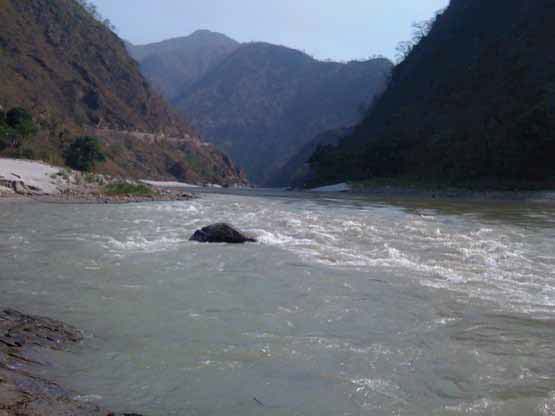 The Ganges river system originates in the Central Himalayas, and extends into the alluvial Gangetic Plains and drains into the Indian Ocean at the Bay of Bengal. In the upstream mountainous regions, hydropower is the main focus of development with mega and micro projects either under construction or being planned in both Nepal and India.
The Ganges river system originates in the Central Himalayas, and extends into the alluvial Gangetic Plains and drains into the Indian Ocean at the Bay of Bengal. In the upstream mountainous regions, hydropower is the main focus of development with mega and micro projects either under construction or being planned in both Nepal and India.
After the main river channel reaches the plains, it is highly regulated with dams, barrages and associated irrigation canals. All this infrastructure development and abstractions affects the river’s flow regime and reduces flows, which, in turn, impacts downstream water availability, water quality and riverine ecosystems. Furthermore, there are concerns that climate change is likely to exacerbate the water scarcity problem in the Ganges Basin. Therefore, modeling the hydrology of the basin is critical for estimation, planning and management of current and future water resources.
The naturalized basin conditions are those that existed prior to the development of multiple water regulation structures, and hence may be seen as a reference condition, a starting point, against which to evaluate the impacts of planned basin development, as well as the impacts of future climate change on basin water resources. The later impacts are also part of the study: the PRECIS regional climate model (RCM) was used to generate climate projections for the Upper Ganga Basin, with subsequent simulations of future river flows.
The main points that emerged from the study are -
- Results show that the annual average precipitation, actual evapotranspiration (ET) and net water yields of the whole basin were 1,192 millimeters (mm), 416 mm and 615 mm, respectively.
- However, there were large variations in both temporal and spatial distribution of these components. Precipitation, ET and water yields were found to be higher in the forested and mountainous upper areas of the Upper Ganga Basin.
- On an annual average, present-day flows throughout the Upper Ganga Basin are about 2-8 per cent lower than in naturalized conditions. The percentage of flow reduction is the highest during the dry months as water is being withdrawn for irrigation.
- Dry and wet season flows under Climate Change (CC) scenario A2 (scenario corresponding to high population growth with slower per capita economic growth and technological change) are lower than those in present climate conditions at upstream locations, but higher at downstream locations of the Upper Ganga Basin.
- Flows under CC scenario B2 (corresponding to moderate population growth and economic development with less rapid and more diverse technological change) are systematically higher and lower than those under CC scenario A2 during dry and wet seasons, respectively.
- The dates of minimum daily discharges are highly variable among stations and between different CC scenarios, while the dates of maximum flow are delayed downstream as a result of the delay in the onset of the monsoon in the lower parts of the basin.
- The report provides actual simulated discharge time series data for all simulated scenarios, in the overall attempt to augment the river flow data for this important river basin and to facilitate the use of these data by any interested party.
Download the report here
/articles/impacts-water-infrastructure-and-climate-change-hydrology-upper-ganges-river-basin